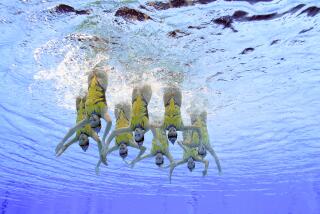The importance of teaching children water safety
Lenny Krayzelberg, an Olympic backstroke swimmer, decided to retire from competitive swimming in 2004 after winning four gold medals for the United States. Knowing that he wanted to continue to work in and around the water, he set up a program for children in Southern California that teaches water safety and swimming, called the Lenny Krayzelberg Swim Academy.
The program has taken off, and Krayzelberg talks to us about the importance of getting youngsters comfortable in the water and ensuring that they are safe.
Tell me about the swim academy.
I was very interested about learn-to-swim programs, and I really started to focus on them more in terms of putting a business together in L.A., which is a great place to get started. The mission of the program is really teaching kids water-safety skills, because, God forbid, they fall in by accident. The rates are staggering — one of the leading causes of accidental death before age 14 is drowning.
Why is it so important for kids to learn water safety at a young age?
First and foremost is to avoid drowning. It’s so preventable. It’s about parents making that choice, that decision, to put their kids into a learn-to-swim program and stick with it. Understanding the dangers in the water and how to behave in the water, those are all the skills we teach in our program.
As you take it a step further, swimming has always been a great recreational activity. You can go on vacation, to the beach, to the lake or to camp, but in the summertime, fun is synonymous with swimming. In order to enjoy the aquatic environment, kids have to feel safe.
Is it difficult for kids to learn to swim?
The main struggle is fear of the water. It really depends on what age the parent brings the child to the pool; the younger they are, the easier it is to work with them. They haven’t developed the fear of the water yet. Others have developed fear; maybe something occurred, or they are just afraid to let go of their parents and be with a stranger.
But ultimately, it’s important to understand that while it might take longer for one kid to learn than another, they all will eventually get used to it and will learn to swim.
What are some of the main challenges when it comes to getting kids water safe?
One big challenge I see — and it’s sad to see — is when a parent brings a 4-year-old, let’s say, and the kid is crying hysterically for two or three lessons. The parent pulls the kid out, saying, “I don’t want to traumatize my child.” It’s a parent quitting on the child. Ultimately that child will get comfortable in the water and will learn to swim. You just shouldn’t give up too soon.
I also think it’s important to understand that learning how to be water safe is not supposed to be fun. There are essentials, and you have to teach them. The child might be crying about learning those essentials, but they’re the difference between being water safe and not being water safe. Once those are in place, the child begins to have fun.
What are the key steps to learning water safety?
The first and most important skill is to be able to float on the back on the water. That is most essential because if you fall in, that first instinct of rolling on your back and floating so you can breathe could be the difference between life and death.
We then teach how to roll from your back to your stomach and be able to kick. In our program, the focus is establishing a good, proper body position, parallel to water. We don’t introduce arms until we establish great body position, until kids can traverse the length of the pool just by kicking.
Once a child is solid in those skills, we progress to introducing arm strokes and rotation in breathing, lifting your head up and breathing to the side. We take the time to build skills and do it in proper progression.
ALSO:
Camping gear: A little less wild in the wilderness
Having trouble sleeping? These products aim to help
Online doctor visits offer convenience and often lower costs
More to Read
Go beyond the scoreboard
Get the latest on L.A.'s teams in the daily Sports Report newsletter.
You may occasionally receive promotional content from the Los Angeles Times.






